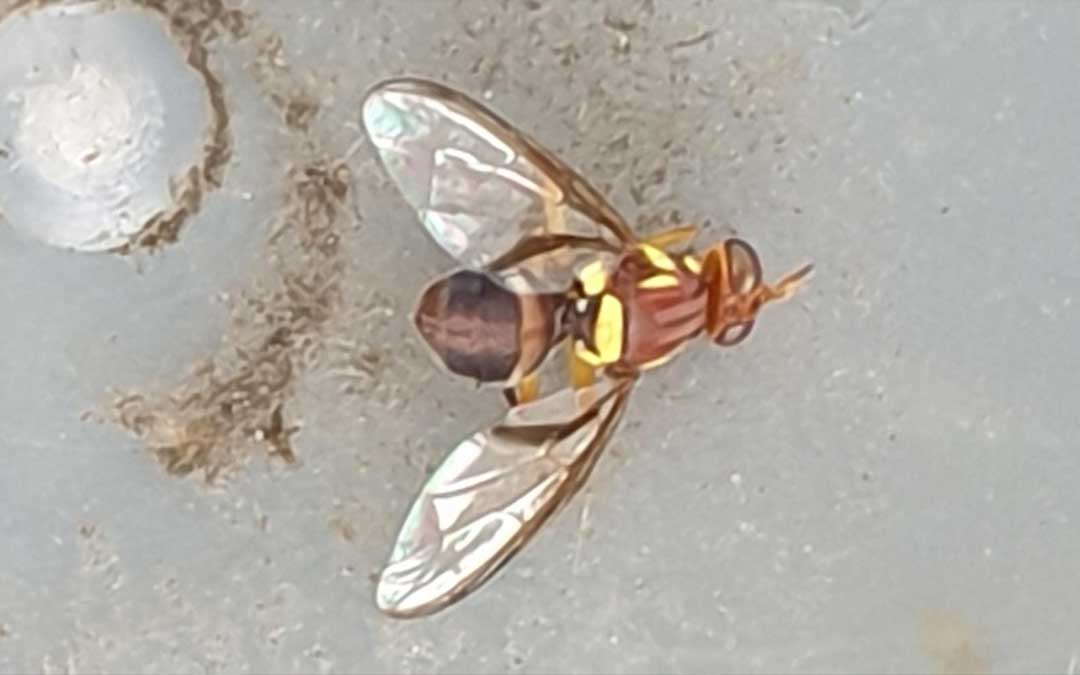Fight Queensland Fruit Fly this season!

Top tips for controlling Queensland Fruit Fly
Use dual methods: pheromone traps and netting together are best.
- Pheromone traps – available from nurseries and Bunnings for about $20. Only one needed per backyard (covers 400 m) and it does not need to be cleared. These traps kill the males.
- Fine netting – to exclude fruit fly. Tie securely at the bottom to keep fruit flies out.
- Protein traps – made with vegemite and water, or fruit juice, sugar and brewers yeast. These traps need to be 2 metres apart, cleared of dead flies, and new bait added fortnightly. These traps kill males and females.
- Remove all affected fruit from trees and the ground and solarise (see instructions below).
For more details, read Anne Paul’s excellent article below.
What is Queensland Fruit Fly?
Queensland Fruit Fly (Qfly) (Bactrocera tryoni) is a gold and black wasp-like insect, the size of a housefly. Originally a native of subtropical and tropical Australia, it has gradually spread to temperate zones throughout eastern Australia, especially with the warming climate.
Queensland Fruit Fly is a significant pest which can infest a wide variety of fruit and fruiting vegetables, both indigenous and introduced, leaving them inedible.
View a full list of Queensland Fruit Fly hosts
Gardeners should treat Qfly as a serious pest.
In 2008, for the first time in twenty years, Qfly was found breeding in Melbourne’s north-western suburbs and in 2015 the Weekly Times headlined:
THE world’s worst fruit pest, Queensland fruit fly, is now in plague proportions across Victoria.
In 2016 research estimated Qfly inflicted $300 million in control and lost market costs for horticulture across Australia.
Qfly’s life cycle is approx 3 weeks. Eggs are laid in fruit, larvae (maggots) hatch and eat fruit, while spreading a bacteria that rots the fruit. Fruit falls to ground and larvae burrow into ground and pupate, then adult flies emerge in 10 days to mate and female lays eggs in fruit.
Qfly favours warm humid weather.
Key Steps and Organic Control
1. Monitor:
Inspect ripening fruit for any sign of Qfly, by looking for sting marks on skin and by cutting fruit open to check inside for maggots.
2. Exclusion
Use a physical barrier of fine weave netting or bags to stop females laying eggs in fruit.
3. Trapping and chemical control
If Qfly are present, gardeners need to use traps to catch and kill them. Use traps with a certified organic bait such as:
- Bait trap that lures and drowns fly – eg Cera Trap
- Baits that contains natural pesticide spinosad – eg Naturalure, Natures Way Fruit Fly Control
- or use in combination.
4. Garden hygiene
Maintain good hygiene in the garden.
Pick fruit as it ripens. With fruit that will ripen after harvesting, like tomatoes, harvest early by picking when semi-ripe.
Prune fruit trees to enable easy fruit picking and where possible use insect nets.
Remove spoilt or rotten fruit and unwanted host plants.
Pick up fallen fruit immediately and destroy any maggots that may be inside by solarising (sealing fruit inside a plastic bag and leaving it in the sun for at least 14 days).
Encourage neighbours to monitor and control Qfly in their gardens.
5. Don’t spread Qfly
Don’t travel with Qfly host fruits, especially those grown at home, which have a higher chance of being infested.
Heavy fines apply for travelling with Qfly host produce into pest free areas.
References and Further Reading
Justin Russell, Controlling Fruit Fly, October 2019
Agriculture Victoria
Written by Anne Paul
